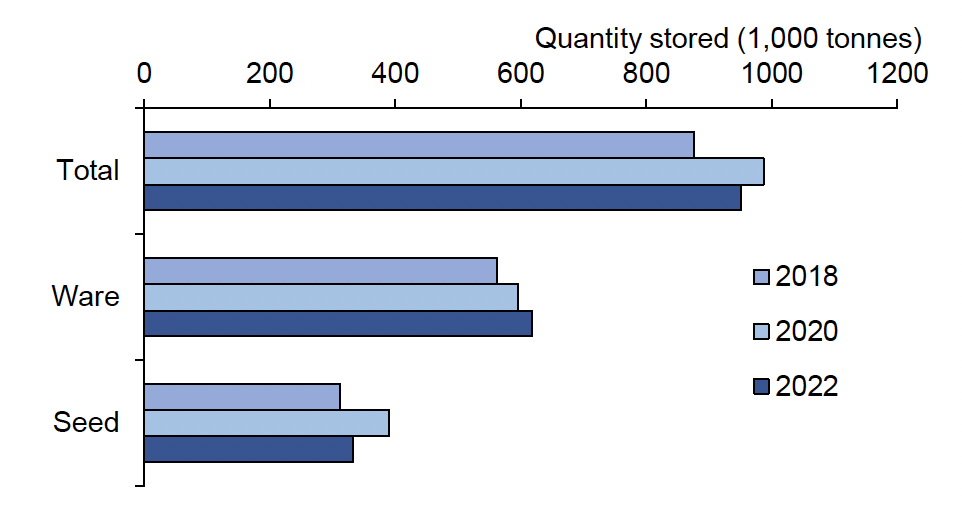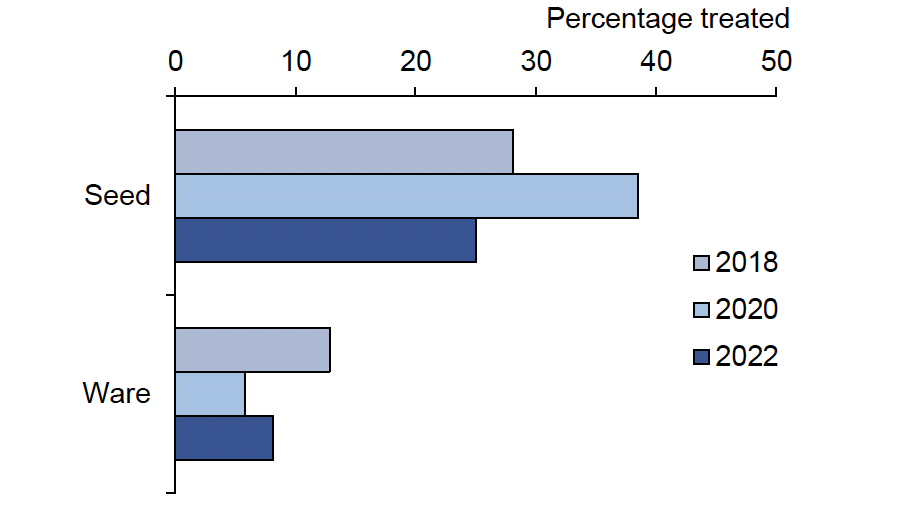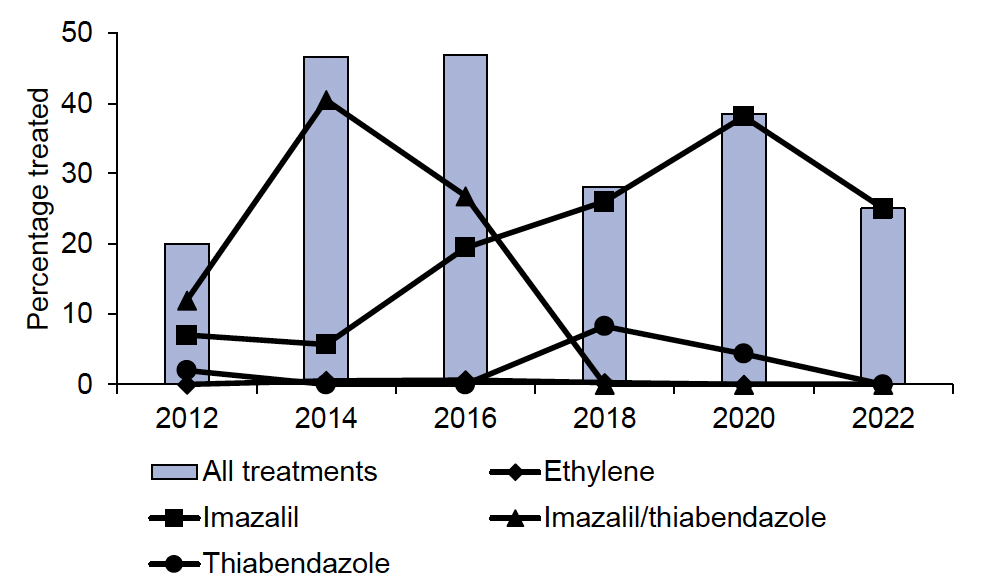Pesticide Usage in Scotland: Arable crops and Potato stores 2022
This publication presents information from a survey of pesticide use on Arable crops and Potato stores in Scotland during 2022.
General trends
Scottish potato storage
The total estimated quantity of potatoes stored in Scotland in 2022 was 951,194 tonnes. This is four per cent less than the 987,615 tonnes reported in 2020(3) and nine per cent more than the estimated 875,687 tonnes in 2018(4). However, there has been a significant change in survey methodology which must be taken into account when comparing data from this survey and previous surveys (see Appendix 4 – changes from previous years for further information).
The quantity of seed potatoes stored in 2022 was estimated to be 332,745 tonnes, representing a 15 per cent decrease in stored seed potatoes since the previous survey in 2020 and a six percent increase since 2018.
The estimated quantity of ware potatoes stored in 2022 was 618,449 tonnes, representing a four per cent increase from 2020 and a ten per cent increase from 2018.
As in 2020 and 2018, all potatoes surveyed in 2022 were stored in boxes. Seed crops were mainly held in refrigerated stores (78 per cent) with the remainder in ambient ventilated stores (22 per cent). There were no seed potatoes encountered in unventilated stores in 2022 (<0.5 per cent in 2020). The majority of seed crops were also held in refrigerated stores in 2020 and 2018 (60 and 67 per cent respectively).
Ware potatoes were mostly refrigerated in 2022 (82 per cent) with 17 per cent in ambient ventilated stores and a very small proportion in unventilated stores (<0.5 per cent). The proportion of ware potatoes refrigerated was similar in 2022 compared to 2020 (86 per cent). However, prior to this the proportion of ware potatoes held in refrigerated stores steadily increased (80, 77 and 66 per cent in 2018, 2016 and 2014 respectively).

Please note, there has been a significant change in survey methodology which must be taken into account when comparing data from 2022 and previous surveys, see Appendix 4 for further information. The above figure presents the estimated total potato storage in Scotland for 2018 using the methodology from the 2020 survey (not the 2018 survey) for comparison purposes.
Pesticide usage
Seed potatoes
The proportion of seed potatoes treated with a pesticide in 2022 was 25 per cent. This is lower than the 39 per cent treated in 2020 but similar to the proportion treated in 2018 (28 per cent). Seed potatoes were lifted in good condition in 2022, which reduced the risk of rots associated with wet soils and a heavy soil loading at harvest(5), which may have influenced the decline in pesticide use in store. Likewise, pesticide use on seed potatoes in 2018 was considered to be low, with the assumption that this was influenced by the good quality of seed potatoes harvested that year.

The only active substance encountered in seed potato stores in 2022 was the fungicide imazalil applied to 25 per cent of the seed crop (Figure 3, Table 2). Imazalil was also the most commonly used fungicide in 2020 and 2018 applied to 38 and 26 per cent of the seed crops respectively. No thiabendazole use was encountered on seed crops in 2022. Its use has declined in recent years (eight per cent in 2018 and four per cent in 2020) which may have been influenced by the occurrence of resistance to thiabendazole in some storage diseases(6).
Prior to 2018 the most commonly used fungicide was a formulation of imazalil/thiabendazole which was applied to 27 per cent of stored seed in 2016 and 40 per cent in 2014. This imazalil/thiabendazole formulation lost approval in 2015 and had a final use date of June 2017.
No ethylene was recorded on stored seed potatoes in 2022 or in 2020. In the three surveys prior to 2020 a small proportion (<1 per cent) of stored seed potatoes were treated with ethylene. In these previous surveys, ethylene use on seed potatoes was only encountered in one commercial store which is no-longer operating. Ethylene, which is generated from ethanol, is not approved as a plant protection product for stored seed potatoes. However, it is approved as a commodity substance for plant growth regulation for post-harvest crops under COPR(7).

Ware potatoes
The proportion of stored ware potatoes treated with a pesticide in 2022 was eight per cent, similar to the six per cent in 2020, but lower than the 13 per cent in 2018 (Figure 2). The decrease in the proportion of the ware crop treated between 2018 and 2020 may have been influenced by the reduced number of approved products available following the loss of the growth regulator active substance chlorpropham.
Similar to the previous survey, less than 0.5 per cent of the stored crop was treated with a fungicide in 2022. Historically, with the exception of 2012, which was an outlier, less than five per cent of stored ware potatoes have been treated with a fungicide over the last decade. Imazalil, the only fungicide encountered in ware potato stores in 2022, is not approved as a plant protection product for stored ware potatoes. It was applied to seed crops which were later reclassified as ware. During 2023, Scottish Government officials wrote to seed potato growers highlighting that imazalil treated crops cannot be used for human or animal consumption.
Almost all the pesticides used in ware stores were growth regulators (>99 per cent, Figure 4). 1,4-dimethylnaphthalene, a sprout suppressant approved for use in potato stores in August 22, was applied to an estimated one per cent of ware potatoes. This active may in future increase in use as chlorpropham which had been the principal active substance in 2018 and 2016 (applied to nine and ten per cent respectively) was withdrawn in 2020.
Ethylene was applied to an estimated four per cent of the stored ware potato crop in 2022 and 2020, compared with eight per cent in 2018. Spearmint oil, which is a sprout suppressant, applied as a fog in store, was applied to an estimated three per cent of the stored ware potato crop in 2022, similar to previous surveys (one per cent in 2020 and two per cent in 2018). It is worth noting, since the loss of chlorpropham in 2020, there has not been a significant increase in the use of other growth regulators in store. However, an increase in the use of maleic hydrazide, applied as a field treatment to prevent sprouting during storage was recorded in the recent Pesticide Usage in Arable Crop reports. Maleic hydrazide was applied to 12 per cent of the ware crop in 2022, compared to eight per cent in 2020 and two per cent in 2018. Although it should be noted that the use of growth regulators has shown variation over time, as have the compounds encountered (Figure 4) and it is difficult to interpret trends within this data series.

Note: this figure corrects some minor errors published in previous reports. Previously, the percentage of stored ware potatoes treated was calculated using the total tonnage treated, rather than basic tonnage treated. See Appendix 3 for definitions. The difference in the percentage of stored ware potatoes treated with a pesticide between methods is low (less than one per cent for all treatments except for chlorpropham, which is impacted by one and two per cent in 2012, 2014 and 2018, and seven per cent in 2016).
Contact
Email: psu@sasa.gov.scot
There is a problem
Thanks for your feedback